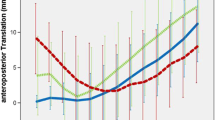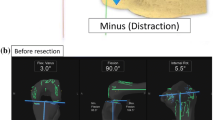Abstract
Purpose
This study aimed to compare the intraoperative kinematics, especially for mid-flexion femorotibial anteroposterior (AP) stability, between newly developed medial congruent (MC) inserts and cruciate-retaining (CR) inserts in navigated cruciate-retaining total knee arthroplasty (CR-TKA).
Methods
Thirty consecutive patients with varus osteoarthritis undergoing CR-TKA using an image-free navigation system were enrolled. AP kinematics, the AP translation under manual maximum stress to the knee joint at 45° flexion, rotational kinematics, and varus–valgus laxity were evaluated using a navigation system and statistically compared between the MC and CR inserts.
Results
AP kinematic analysis showed that the femoral position with the CR insert was significantly anterior at a maximum extension to 45° flexion compared with the MC insert (p < 0.05). The amount of AP translation at 45° flexion with the MC insert was significantly smaller than that with the CR insert (p < 0.05). Rotational kinematics found that the tibial position at maximum extension was significantly externally rotated with the MC inserts than with the CR inserts. Varus–valgus laxity was comparable between the MC and CR inserts.
Conclusion
The current results showed that greater mid-flexion AP stability was achieved with the MC inserts than with the CR inserts in CR-TKA. Intraoperative kinematics with the MC inserts more closely resembled those with preoperative conditions in CR-TKA.
Level of evidence
III, prospective comparative study.





Similar content being viewed by others
References
Akagi M, Mori S, Nishimura S, Nishimura A, Asano T, Hamanishi C (2005) Variability of extraarticular tibial rotation references for total knee arthroplasty. Clin Orthop Relat Res 436:172–176
Banks SA, Hodge WA (2004) 2003 Hap Paul Award Paper of the International Society for Technology in Arthroplasty: design and activity dependence of kinematics in fixed and mobile-bearing knee arthroplasties. J Arthroplast 19(7):809–816
Dennis DA, Komistek RD, Colwell CEJ, Ranawat CS, Scott RD, Thornhill TS et al (1998) In vivo anteroposterior femorotibial translation of total knee arthroplasty: a multicenter analysis. Clin Orthop Relat Res 356:47–57
Dennis DA, Komistek RD, Mahfouz MR, Haas BD, Stiehl JB (2003) Conventry award paper: multicenter determination of in vivo kinematics after total knee arthroplasty. Clin Orthop Relat Res 416:37–57
Dennis DA, Komistek RD, Mahfouz MR (2003) In vivo fluoroscopic analysis of fixed-bearing total knee replacements. Clin Orthop Relat Res 410:114–130
Fujimoto E, Sasashige Y, Masuda Y, Hisatome T, Eguchi A, Masuda T et al (2013) Significant effect of the posterior tibial slope and medial/lateral ligament balance on knee flexion in total knee arthroplasty. Knee Surg Sports Traumatol Arthrosc 21(12):2704–2712
Han HS, Seong SC, Lee S, Lee MC (2006) Rotational alignment of femoral components in total knee arthroplasty: nonimage-based navigation system versus conventional technique. Orthopedics 29(10 Suppl):S148–151
Hasegawa M, Naito Y, Yamaguchi T, Wakabayashi H, Sudo A (2018) Factors contributing to patient satisfaction and expectations following computer-assisted total knee arthroplasty. J Knee Surg 31(5):448–452
Hino K, Ishimaru M, Iseki Y, Watanabe S, Onishi Y, Miura H (2013) Mid-flexion laxity is greater after posterior stabilised total knee replacement than with cruciate-retaining procedures: a computer navigation study. Bone Jt J 95(4):493–497
Indelli PF, Risitano S, Hall KE, Leonardi E, Migliore E (2019) Effect of polyethylene conformity on total knee arthroplasty early clinical outcomes. Knee Surg Sports Traumatol Arthrosc 27(4):1028–1034
Ishida K, Shibanuma N, Matsumoto T, Sasaki H, Takayama K, Hiroshima Y et al (2016) Navigation-based tibial rotation at 90 degrees of flexion is associated with better range of motion in navigated total knee arthroplasty. Knee Surg Sports Traumatol Arthrosc 24(8):2447–2452
Ishida K, Matsumoto T, Tsumura N, Kubo S, Kitagawa A, Chin T et al (2011) Mid-term outcomes of computer-assisted total knee arthroplasty. Knee Surg Sports Traumatol Arthrosc 19(7):1107–1112
Ishida K, Shibanuma N, Matsumoto T, Sasaki H, Takayama K, Toda A et al (2015) Factors affecting intraoperative kinematic patterns and flexion angles in navigated total knee arthroplasty. Knee Surg Sports Traumatol Arthrosc 23(6):1741–1747
Kim TW, Lee SM, Seong SC, Lee S, Jang J, Lee MC (2016) Different intraoperative kinematics with comparable clinical outcomes of ultracongruent and posterior stabilized mobile-bearing total knee arthroplasty. Knee Surg Sports Traumatol Arthrosc 24(9):3036–3043
Martin JW, Whiteside LA (1990) The influence of joint line position on knee stability after condylar knee arthroplasty. Clin Orthop Relat Res 259:146–156
Ng JWG, Bloch BV, James PJ (2019) Sagittal radius of curvature, trochlea design and ultracongruent insert in total knee arthroplasty. EFFORT Open Rev 4(8):519–524
Piriou P, Pernonne E, Ouanezar H (2013) Rotational alignment of the femoral component using trochlear navigation during total knee arthroplasty: a dual-center study of 145 cases. J Arthroplast 28(7):1107–1111
Ramappa M (2015) Midflexion instability in primary total knee replacement: a review. SICOT J 5(1):24
Sabatini L, Risitano S, Parisi G, Tosto F, Indelli PF, Atzori F et al (2018) Medial pivot in total knee arthroplasty: literature review and our first experience. Clin Med Insights Arthritis Musculoskelet Disord 11:1179544117751431
Tei K, Ishida K, Matsumoto T, Kubo S, Sasaki H, Shibanuma N et al (2012) Novel image-matching software for postoperative evaluation after TKA. Orthopedics 35(12):e1711–1715
Walker PS, Sathasivam S (2000) Design forms of total knee replacement. Proc Inst Mech Eng H 214(1):101–119
Yue B, Varadarajan KM, Moynihan AL, Liu F, Rubash HE, Li G (2011) Kinematics of medial osteoarthritic knees before and after posterior cruciate ligament retaining total knee arthroplasty. J Orthop Res 29(1):40–46
Funding
This study was not funded by any company.
Author information
Authors and Affiliations
Corresponding author
Ethics declarations
Conflict of interest
No author associated with this paper has disclosed any potential or pertinent conflicts which may be perceived to have impending conflict with this work.
Ethical approval
All procedures performed in this study involving human participants were in accordance with the ethical standards of the institutional and/or national research committee and with the 1964 Helsinki declaration and its later amendments or comparable ethical standards.
Informed consent
Informed consent was obtained from all individual participants included in the study.
Additional information
Publisher's Note
Springer Nature remains neutral with regard to jurisdictional claims in published maps and institutional affiliations.
Rights and permissions
About this article
Cite this article
Tsubosaka, M., Ishida, K., Kodato, K. et al. Mid-flexion stability in the anteroposterior plane is achieved with a medial congruent insert in cruciate-retaining total knee arthroplasty for varus osteoarthritis. Knee Surg Sports Traumatol Arthrosc 29, 467–473 (2021). https://doi.org/10.1007/s00167-020-05927-4
Received:
Accepted:
Published:
Issue Date:
DOI: https://doi.org/10.1007/s00167-020-05927-4




